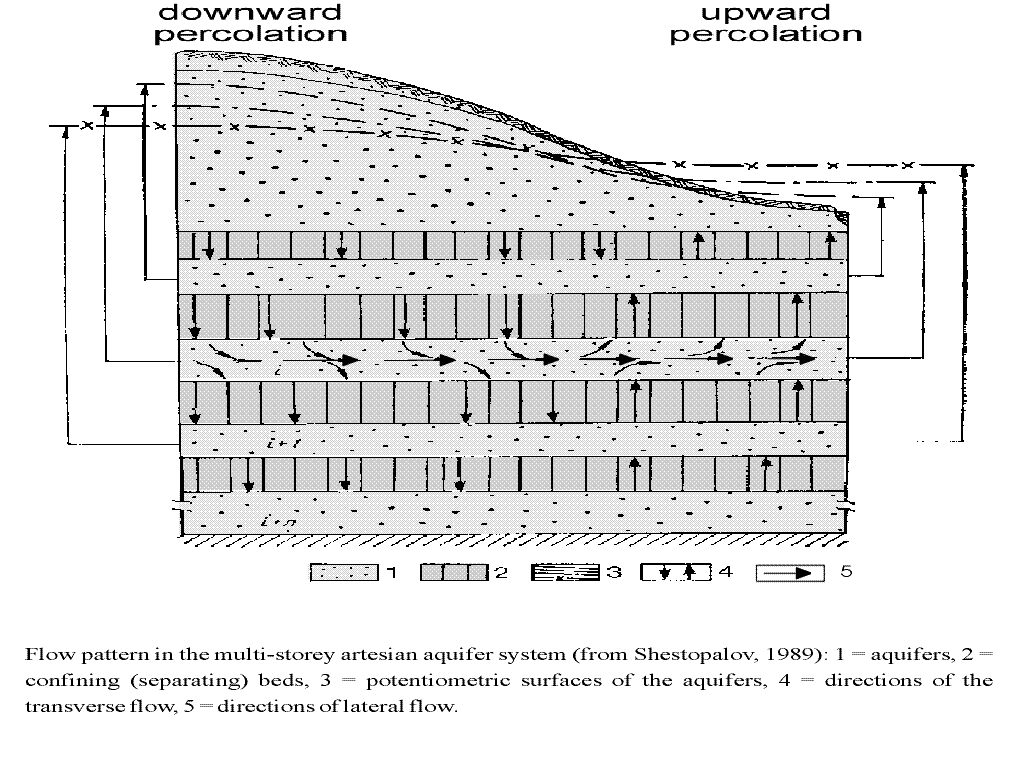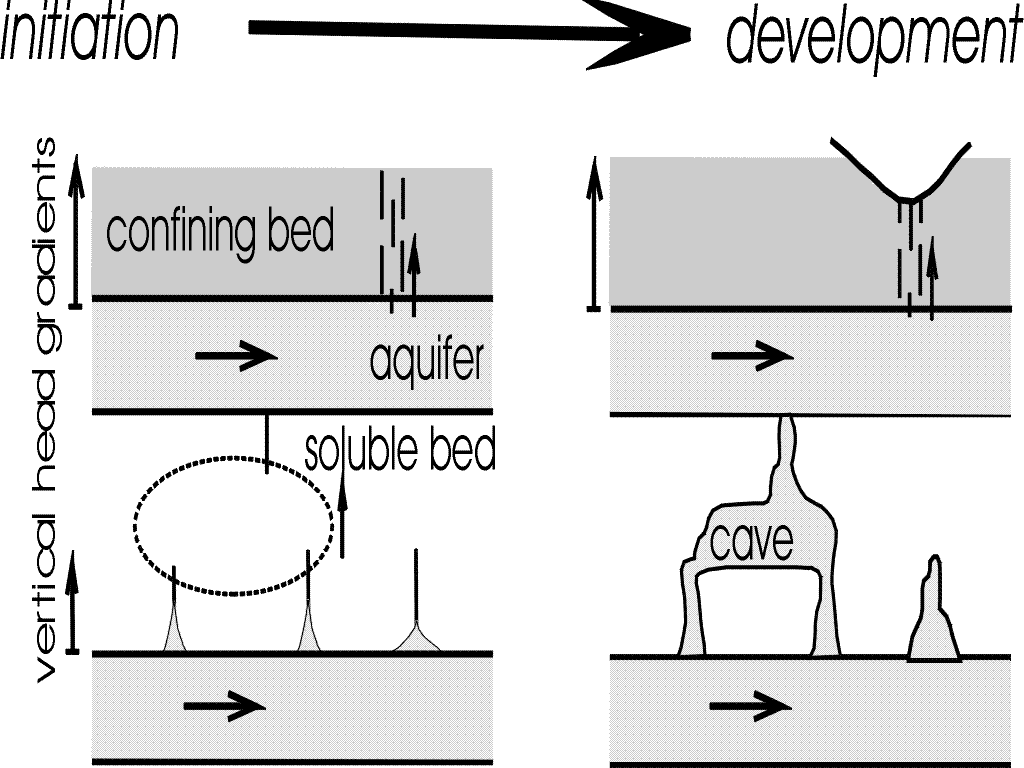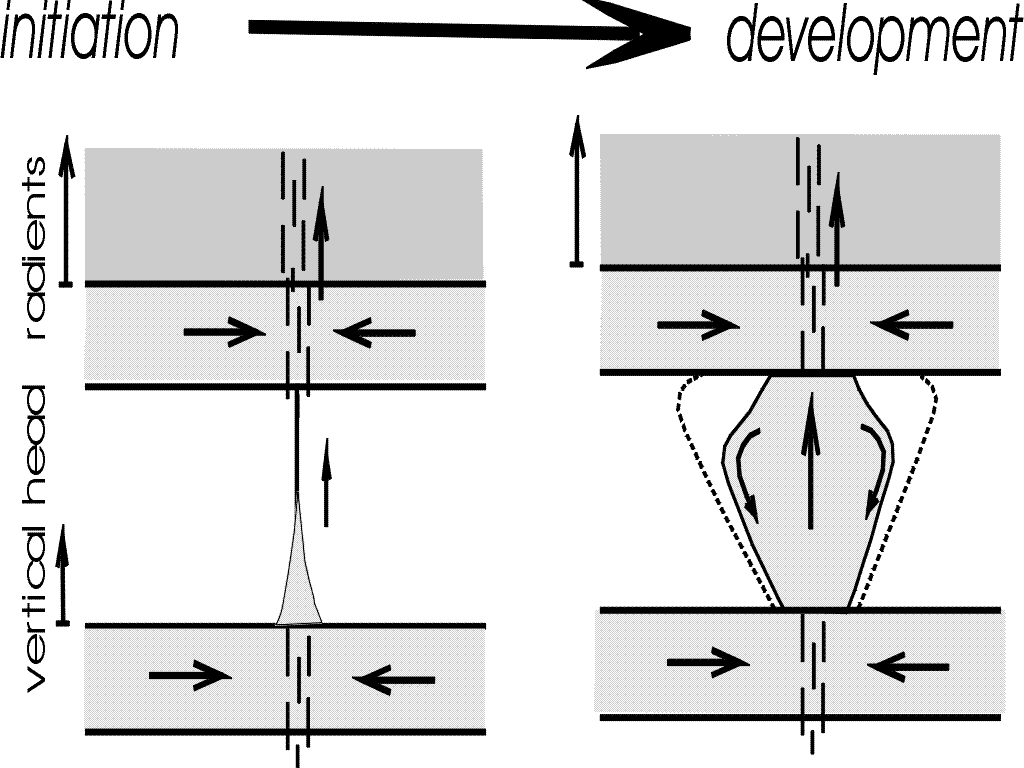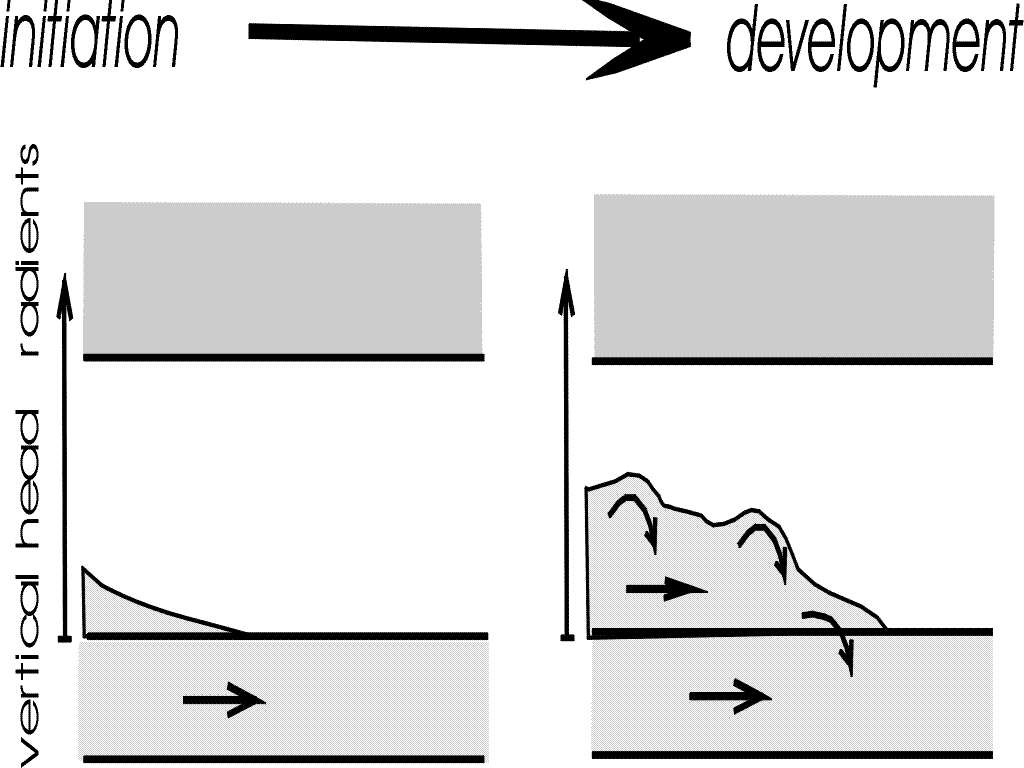
UNIFIED CONCEPTUAL MODEL
1. SPELEOGENESIS
The ROSES Project deals with localized land subsidence due to dissolution phenomena attributed to karst processes. Karst is treated here as a specific kind of fluid circulation system capable of self-development and self-organization. Adapting a proposal of Huntoon (1995), it may be defined as follows: -
The karst system is an integrated mass-transfer system in soluble rocks with a permeability structure that is dominated by conduits dissolved from the rock and organized to facilitate the circulation of fluid in a downgradient direction.
The critical element in this definition is the recognition the importance of hydrogeological evolution.Different types of karst can be viewed as successive stages in development within a unified concept of karst evolution. Despite local peculiarities, at a global scale the major boundary conditions, extrinsic factors and intrinsic mechanisms of karst development appear to change between stages in a regular way over the course of geological evolution. Therefore, such an evolutionary typology can also be a means to classify karst/speleogenetic settings. The different types of karst are marked by characteristic associations of the structural prerequisites for groundwater flow and speleogenesis, such as, flow regime, recharge mode and recharge/discharge configurations, groundwater chemistry and degree of inheritance from earlier conditions. The evolutionary karst sequence can also be linked to the relationships with insoluble cover beds. Consequently, these associations provide a convenient basis from which to view the factors that control the origin of particular karst features including subsidence and its triggering forms and mechanisms.

Open and Denuded karst
These types are characterized by similarly exposed geomorphological settings but differ in their previous karstification history. Whereas denuded karst is former intrastratal karst, open karst represents the "pure line" of exposed development, that is karst evolved solely when the soluble rock has been exposed to the surface, with limited or no inheritance. In reality no individual karst is known that displays all of its possible sequence but many have experienced several of the components. The karst may be destroyed completely, along with its host formation, within the same stage that its development commenced: this is more common for karst in sulphates than in carbonates and is the fate of most salt.
Intrastratal karst is considered to be developed within rocks already buried by younger strata, where karstification is later than deposition of the cover rocks. As a consequence of denudation and uplift on the continents, the deep-seated rocks are shifted with time into progressively shallower positions. The boundaries between stages are transitional in reality but can be drawn in the following way: deep-seated karst is not evident at the surface and the soluble rock is not exposed; subjacent karst occurs where the soluble rock is locally breached by erosion over a minor part of its thickness and karst features may already be expressed at the surface at springs and/or collapse features; entrenched karst occurs where the entire thickness of the soluble rock is entrenched along valleys but the insoluble cap remains over most of the interfluves, and denuded karst is where the cap rocks are removed. Where there is continuous karst development from the deep-seated stage to the denuded stage the role of inheritance can be quite important.
2. CONCEPTUAL MODELS OF CONDUIT EVOLUTION IN GYPSUM
Differences in solution kinetics between gypsum and calcite impose some peculiar features on the evolution of conduits in gypsum, especially at the earliest stage. It has been shown (Palmer, 1984, 1991; Dreybrodt, 1996; Dreybrodt & Gabrovsek, 1999) that initiation of early, narrow and long pathways is not feasible under linear dissolution rate laws (reaction order, n=1) due to exponential decrease of the dissolution rates. For carbonates, (non-linear kinetics; n>2) this problem is resolved by recognizing that the decrease of dissolution rates proceeds by a hyperbolic relation. This means that, dissolution rates at the exit of a fissure are still sufficiently high to achieve enlargement and breakthrough (enlargement and increase in discharge at which the process switches to rapid dissolution at low saturation indices) within geologically reasonable times.
Although the dissolution kinetics of gypsum are not well known close to equilibrium it is generally assumed that they are controlled entirely by diffusion and are therefore linear (James & Lupton, 1978; Lui &. Dreybrodt, 1997). If dissolution of gypsum is solely diffusion-controlled, with no change in the kinetic order, conduit initiation along tight and long fissures could not occur in unconfined phreatic settings or by lateral flow through gypsum from distant recharge areas in artesian settings. However, cavities are shown to develop in gypsum in artesian conditions (such as in Darlington and Ripon, UK, and in the zones of subjacent and deep-seated karsts in the Western Ukraine. This paradox has been reconciled recently on the basis of the new conceptual models of cave-generating flow patterns and of conduit growth under confined conditions (Klimchouk, 1997a; 1999a, b). These conceptual models are being further developed within the ROSES project in order to be implemented in mathematical modelling of conduit growth in gypsum.
Conduit evolution in unconfined settings
Unlike limestone, gypsum does not support a kinetic mechanism which allows slow but uniform dissolutional enlargement throughout the incipient flow paths. Hence initiation of long lateral flow paths through gypsum is virtually impossible and no deep phreatic development can occur in unconfined settings. In shallow phreatic conditions of open gypsum karsts some fissures are wide enough to maintain undersaturated flow throughout, so cave development can occur. It is extremely competitive due to rapid dissolution kinetics and the strong dependence of enlargement rates on flow velocity and discharge. Thus speleogenesis in gypsum in exposed settings is expected, and seen (Klimchouk, 1996), to produce mainly linear or crudely branching conduit patterns which rapidly adjust to the contemporary geomorphological setting and maximum available recharge. When incising valleys lower the base-level of drainage to positions within or below the gypsum strata, low-gradient water table (or sometimes perched) conditions are established very quickly because of the high conduit permeability. These peculiarities of gypsum speleogenesis cause extreme heterogeneity and anisotropy of karst permeability in open gypsum karsts where little or no previous karstification has occurred. No substantial flow occurs at great depth below the water table because deep-phreatic speleogenesis does not occur in gypsum (Forti, 1993; Klimchouk, 1996c).
Non-traditional concept of artesian flow
In contrast to the classic view of the hydrodynamics of artesian basins, the non-classic view ( for reviews see Shestopalov,1981, 1989; Toth, 1995) acknowledges that there are virtually no impervious rocks or sediments; just large contrasts in permeabilities. According to this, recharges and discharges can occur throughout the whole confined area, and are controlled by influenced by topography and zones of enhanced permeability. Recharge areas occur where the heads in the aquifer are lower than adjacent aquifers in the basin, and discharge occurs where the head relationship between adjacent aquifers is opposite. Thus in a multistorey arstesian system in which geomorphological incisions modify head relationships there is a gradual horizontal transition between simultaneously occurring net recharge and net discharge. These give rise to dominantly vertical flow through the aquifer units.
MULTISTOREY ARTESIAN SYSTEM

Prior to speleogenesis, permeabilities of common aquifers are normally greater then that of soluble units such as massive limestones or sulphates; the latter initially act as separating beds (aquitards). As late diagenesis and tectonism impose fissure permeability, soluble units increasingly transmit groundwater between "normal" (non-karstic) aquifers in zones of sufficient hydraulic gradient. Where the soluble unit is sandwiched between formations with initially higher permeability, is the most favourable for artesian speleognesis. Gradient fields in multi-storey confined aquifer systems generally promote transverse circulation and speleogenesis in the soluble unit. As speleogenesis proceeds, the permeability of the soluble unit becomes much higher that that of the adjacent aquifers.
The concept of cross-formation hydraulic communication has been largely overlooked in karst hydrogeology and speleogenetic studies. It obviously has important speleogenetic implications and allows new approaches to understanding karst development in confined and deep-seated settings.
Conduit evolution in confined settings
The stages of artesian speleogenesis arise from the fact that discharge through a passage is always hydraulically controlled i.e. dependent on the hydraulic capacity of:
The two latter cases display the external hydraulic controls that can also be termed the constrained outflow control. Recharge to a cave system can be viewed as unlimited, considering that the discharge is constrained; this is by definition an inherent feature of artesian settings. Rates of conduit enlargement depend more on the mass balance than on solution kinetics (Palmer, 1995). In contrast, the hydraulic control on discharge in unconfined phreatic settings, characteristic of the early stages of phreatic speleogenesis, switches to catchment control at a later development stage, when the available recharge becomes the limiting factor in flow through the system (Palmer, 1984). Within artesian speleogenesis, recharge to a soluble unit comes from the adjacent permeable but insoluble formation, not from the surface. This makes discharge somewhat insensitive to variations of fissure width: a ten-fold difference in fissure width produces only a two-fold difference in discharge (Palmer, 1975, 1991). This also favours uniform growth of many alternative conduits rather than competing development.
Three settings can be envisaged
Transverse flow across the soluble bed through uniformly distributed fissures
This is the first setting to be modelled using the EVE code and is described conceptually below.
 At the
initiation stage, prior to breakthrough, the growth of a single transverse
conduit (fissure, or sequence of connecting fissures) occurs rapidly at the
input end but very slowly along most of its length. After breakthrough, the
enlargement rate and discharge through the early conduit will increase to
some extent, although not drastically, causing drawdown in the lower aquifer
and a depression cone to form around the fissure inlet. Discharge to the
fissure will then depend on the aquifer transmissivity and storativity, the
overall head gradient between the aquifers, and local conditions around the
conduit inlet, but will depend only slightly on further increases in conduit
width. The head differences between the aquifers will be rapidly minimized
within the depression cone. Hence, reaching a steady regime, discharge and
enlargement rates will increase only slightly with further growth of the
conduit through the main stage of artesian development .
At the
initiation stage, prior to breakthrough, the growth of a single transverse
conduit (fissure, or sequence of connecting fissures) occurs rapidly at the
input end but very slowly along most of its length. After breakthrough, the
enlargement rate and discharge through the early conduit will increase to
some extent, although not drastically, causing drawdown in the lower aquifer
and a depression cone to form around the fissure inlet. Discharge to the
fissure will then depend on the aquifer transmissivity and storativity, the
overall head gradient between the aquifers, and local conditions around the
conduit inlet, but will depend only slightly on further increases in conduit
width. The head differences between the aquifers will be rapidly minimized
within the depression cone. Hence, reaching a steady regime, discharge and
enlargement rates will increase only slightly with further growth of the
conduit through the main stage of artesian development .
Transverse flow across the soluble bed through a single prominent fissure
 In the
case of a fault or prominent tectonic fissure crossing an otherwise poorly
fissured soluble bed and providing a path of high permeability, transverse
flow will be focused along it. A potential distinction in comparison with
Case 1 described above is that such prominent disruption commonly intersects
several aquifers and confining beds below and above the soluble unit, thus
allowing substantial discharge through it. If not existing initially,
breakthrough conditions can be met fairly rapidly. The rate of further
enlargement may then achieve its maximum possible value because a comparatively
large discharge can be maintained through the conduit. Outflow from the system
may be constrained to a much higher level than in the case A, although this
depends on local circumstances. Either way, the development of quite large
isolated voids can be envisaged, especially if a strong hydrogeochemical
mechanism is involved, or the soluble bed consists of evaporites. In the
latter case, natural convection-circulation may contribute substantially
to the process.
In the
case of a fault or prominent tectonic fissure crossing an otherwise poorly
fissured soluble bed and providing a path of high permeability, transverse
flow will be focused along it. A potential distinction in comparison with
Case 1 described above is that such prominent disruption commonly intersects
several aquifers and confining beds below and above the soluble unit, thus
allowing substantial discharge through it. If not existing initially,
breakthrough conditions can be met fairly rapidly. The rate of further
enlargement may then achieve its maximum possible value because a comparatively
large discharge can be maintained through the conduit. Outflow from the system
may be constrained to a much higher level than in the case A, although this
depends on local circumstances. Either way, the development of quite large
isolated voids can be envisaged, especially if a strong hydrogeochemical
mechanism is involved, or the soluble bed consists of evaporites. In the
latter case, natural convection-circulation may contribute substantially
to the process.
Large voids formed in the soluble bed can trigger major breakdown and the development of vertical through structures (VTS; Klimchouk & Andrejchouk, 1996), commonly referred to as breccia pipes, collapse columns, etc. These characteristic features of deep-seated karst may reach remarkable vertical extension, up to many hundreds of meters, by upward stoping across a multi-storey artesian system that includes soluble beds. VTS are not merely breakdown structures, but complex hydrogeological structures the development of which depends on (and favours) focused cross-formational groundwater circulation and continuing dissolution of intercepted soluble beds and infallen clasts (Huntoon, 1996; Klimchouk & Andrejchouk, 1996).
Lateral flow in the aquifer underlying a non-fissured soluble bed
 In this
case the non-fissured soluble unit is virtually impermeable and does not
permit transverse flow through it. Instead, some lateral development may
occur along the contact with the adjacent aquifer. The dissolved load can
be removed from the lithologic interface by diffusion or convection, then
outflowing with the regional flow. It is likely that some sizeable conduits
or voids can develop in this way. Lateral contact speleogenesis is quite
common in confined settings where evaporites are sandwiched between aquifers,
or underlain by an aquifer.
In this
case the non-fissured soluble unit is virtually impermeable and does not
permit transverse flow through it. Instead, some lateral development may
occur along the contact with the adjacent aquifer. The dissolved load can
be removed from the lithologic interface by diffusion or convection, then
outflowing with the regional flow. It is likely that some sizeable conduits
or voids can develop in this way. Lateral contact speleogenesis is quite
common in confined settings where evaporites are sandwiched between aquifers,
or underlain by an aquifer.